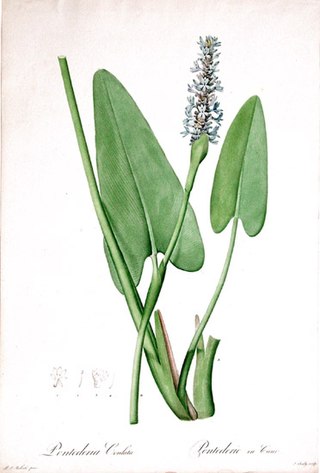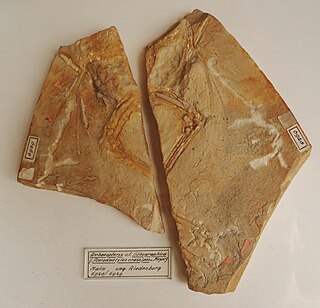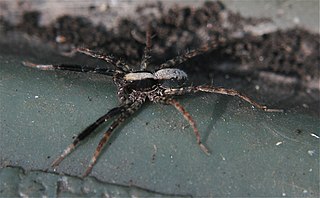
Pontederia is a genus of tristylous aquatic plants, members of which are commonly known as pickerel weeds. Pontederia is endemic to the Americas, distributed from Canada to Argentina, where it is found in shallow water or on mud. The genus was named by Linnaeus in honour of the Italian botanist Giulio Pontedera.

Selenocosmia crassipes, synonym Phlogius crassipes, also known as the "Queensland whistling tarantula", "barking spider" or "bird-eating tarantula" is a species of tarantula native to the east coast of Queensland, Australia. The name "whistling tarantula" comes from its ability to produce a hissing noise when provoked, a trait it shares with other Australian theraphosids. This hissing is produced by the spider stridulating a patch of setae associated with its chelicerae. It has also been called the "eastern tarantula". The species name crassipes is Latin for "fat leg" referring to the relatively fat front legs.
Amaranthus crassipes, also known as spreading amaranth, is a glabrous annual plant that is both native and introduced in the United States. In the U.S., it is found in New Mexico, Arizona, Texas, Alabama, South Carolina, and Louisiana. It is also found in Mexico, the West Indies, and South America.

Pontederia crassipes, commonly known as common water hyacinth, is an aquatic plant native to South America, naturalized throughout the world, and often invasive outside its native range. It is the sole species of the subgenus Oshunae within the genus Pontederia. Anecdotally, it is known as the "terror of Bengal" due to its invasive growth tendencies.

Pachygrapsus crassipes, the striped shore crab or lined shore crab, is a small crab found on both rocky and hard-mud soft seashores of the northeastern and northwestern Pacific Ocean. In North America, this species occurs from central Oregon, south through California to near Ensenada, Baja California, Mexico. There is an isolated population with a wide range disjunction at Bamfield on Vancouver Island, Canada. The western Pacific population, including both Korea and Japan is isolated with a divergence time from the eastern Pacific population estimated between 0.8 and 1.2 Mya.
Hysterocrates crassipes is a species of spiders in the family Theraphosidae (tarantulas) found in Cameroon, Africa.
Oreocarya crassipes is a rare species of flowering plant in the borage family known by the common name Terlingua Creek cat's-eye. It is endemic to Brewster County, Texas, where it is known from only ten populations totaling about 5000 plants. All of the occurrences are within a ten-kilometer radius. This is a federally listed endangered species.

Sybrinus is a genus of longhorn beetles of the subfamily Lamiinae, containing the following species:
Sybrinus grossepunctipennis is a species of beetle in the family Cerambycidae. It was described by Stephan von Breuning in 1950.
Sybrinus persimilis is a species of beetle in the family Cerambycidae. It was described by Stephan von Breuning in 1950.
Sybrinus albosignatus is a species of beetle in the family Cerambycidae. It was described by Stephan von Breuning in 1948.
Sybrinus flavescens is a species of beetle in the family Cerambycidae. It was described by Stephan von Breuning in 1948.
Sybrinus simonyi is a species of beetle in the family Cerambycidae. It was described by Gahan in 1903.

Sybrinus commixtus is a species of beetle in the family Cerambycidae. It was described by Gahan in 1900.
Sybrinus x-ornatus is a species of beetle in the family Cerambycidae. It was described by Téocchi, Jiroux and Sudre in 2007. It is known from Yemen.

Dorcadion crassipes is a species of beetle in the family Cerambycidae. It was described Ballion by 1878.

Ostromia is a genus of anchiornithid theropod dinosaur from the Late Jurassic Painten Formation of Germany. The genus contains a single species, O. crassipes, named by Christian Foth and Oliver Rauhut in 2017.

Schizocosa crassipes is a species of wolf spider in the family Lycosidae. It is found in the United States.
Helocarpaceae is a family of lichen-forming fungi in the subclass Lecanoromycetidae. The family is monotypic, and contains the single genus Helocarpon.







